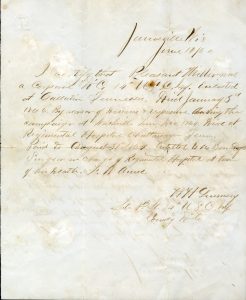By Rob DeHart
Tennessee State Museum

In the opening episode of Season 2 of Mercy Street, a smallpox epidemic ravages a camp for freed African Americans. Mansion House’s doctors initially ignore the epidemic, viewing it as a “slave disease,” until Nurse Mary Phinney eventually convinces the hospital to take it seriously.
 This was an all too common occurrence during the Civil War. As we saw in Mercy Street’s first season, medical practitioners during this era were just beginning to recognize the link between cleanliness and disease. It was more common to blame the smallpox epidemic on the victims’ ethnicity rather than on the unsanitary conditions of the camp and lack of adequate nutrition. Further, military leaders often unknowingly encouraged the spread of disease by not allowing the proper burial of victims or by neglecting to burn the contaminated items of patients.
This was an all too common occurrence during the Civil War. As we saw in Mercy Street’s first season, medical practitioners during this era were just beginning to recognize the link between cleanliness and disease. It was more common to blame the smallpox epidemic on the victims’ ethnicity rather than on the unsanitary conditions of the camp and lack of adequate nutrition. Further, military leaders often unknowingly encouraged the spread of disease by not allowing the proper burial of victims or by neglecting to burn the contaminated items of patients.
Historian Jim Downs documents how African Americans disproportionately suffered from disease during the Civil War in his book Sick from Freedom (2012). Downs estimates at least 60,000 former slaves died from smallpox between 1862 and 1870 from an epidemic that began in Washington and spread throughout the South. Mortality statistics for civilians are not well documented from this period, but Downs believes as many as a quarter of the four million slaves freed by the war may have died from disease – a statistic that is largely omitted when discussing Civil War casualties.
Evidence suggests that smallpox is as old as civilization itself. Pathological examinations of Egyptian mummies have alluded to the presence of smallpox scars, and reports of the disease are found in early European, Asian, and African accounts. In England during the 1700s, the fatality rate for smallpox outbreaks ranged from 20 to 60 percent, and the disease proved especially deadly in infants. Smallpox did not exist in the Americas before the arrival of Europeans, which explains why it so devastated Native American populations during the era of exploration.

It is also tragic that smallpox epidemics were so preventable. As early as the 1720s, physicians experimented with inoculation for smallpox. They noticed that victims who survived the disease did not get it a second time. Physicians began taking contaminated material from the sores of smallpox victims and infecting the skin of healthy patients. Results were promising: People intentionally given the disease died at a significantly lower rate than those who naturally contracted it. One early advocate of smallpox inoculation was Gen. George Washington, who persuaded the Continental Congress to allow the inoculation of American military recruits.
By the early 1800s, British physician Edward Jenner published his experiments on using the cowpox virus to immunize humans against smallpox. The viruses are similar, but cowpox is much less lethal to people. Jenner was not the first to recognize its ability to make humans immune to smallpox, but his publication – which named the procedure after vaccinia, the Latin word for cowpox – started a movement to promote vaccination against smallpox in Europe and the United States.
Although medical science could have declared victory over smallpox, 19th-century doctors did not widely practice vaccination, and smallpox became a disease associated with poverty and people of color. The unsanitary conditions and deadly diseases faced by freed African Americans who fled to Union contraband camps are poignant to consider; however, for most it was still likely preferable to the misery of bondage.
Rob DeHart received his M.A. in public history from Middle Tennessee State University, is a peer reviewer for the American Alliance of Museums and is currently developing content for the new Tennessee State Museum opening in 2018.